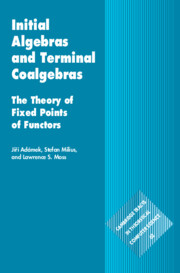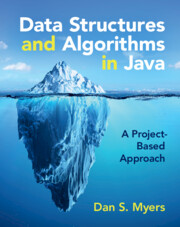Refine search
Actions for selected content:
6950 results in Algorithmics, Complexity, Computer Algebra, Computational Geometry
12 - Liftings and Extensions from Set
-
- Book:
- Initial Algebras and Terminal Coalgebras
- Published online:
- 30 January 2025
- Print publication:
- 06 February 2025, pp 398-460
-
- Chapter
- Export citation
Satisfiability thresholds for regular occupation problems
- Part of
-
- Journal:
- Combinatorics, Probability and Computing / Volume 34 / Issue 4 / July 2025
- Published online by Cambridge University Press:
- 04 February 2025, pp. 491-527
-
- Article
-
- You have access
- Open access
- HTML
- Export citation
Critical configurations of the hard-core model on square grid graphs
- Part of
-
- Journal:
- Combinatorics, Probability and Computing / Volume 34 / Issue 3 / May 2025
- Published online by Cambridge University Press:
- 04 February 2025, pp. 445-485
-
- Article
-
- You have access
- Open access
- HTML
- Export citation

Initial Algebras and Terminal Coalgebras
- The Theory of Fixed Points of Functors
-
- Published online:
- 30 January 2025
- Print publication:
- 06 February 2025
On perfect subdivision tilings
- Part of
-
- Journal:
- Combinatorics, Probability and Computing / Volume 34 / Issue 3 / May 2025
- Published online by Cambridge University Press:
- 27 January 2025, pp. 421-444
-
- Article
- Export citation
Hypergraph independence polynomials with a zero close to the origin
- Part of
-
- Journal:
- Combinatorics, Probability and Computing / Volume 34 / Issue 4 / July 2025
- Published online by Cambridge University Press:
- 22 January 2025, pp. 486-490
-
- Article
- Export citation
Structural convergence and algebraic roots
- Part of
-
- Journal:
- Combinatorics, Probability and Computing / Volume 34 / Issue 3 / May 2025
- Published online by Cambridge University Press:
- 23 December 2024, pp. 392-400
-
- Article
- Export citation

Data Structures and Algorithms in Java
- A Project-Based Approach
-
- Published online:
- 19 December 2024
- Print publication:
- 31 October 2024
-
- Textbook
- Export citation
Essential covers of the hypercube require many hyperplanes
- Part of
-
- Journal:
- Combinatorics, Probability and Computing / Volume 34 / Issue 3 / May 2025
- Published online by Cambridge University Press:
- 16 December 2024, pp. 326-337
-
- Article
- Export citation
Tree universality in positional games
- Part of
-
- Journal:
- Combinatorics, Probability and Computing / Volume 34 / Issue 3 / May 2025
- Published online by Cambridge University Press:
- 13 December 2024, pp. 338-358
-
- Article
- Export citation
Twin-width of sparse random graphs
- Part of
-
- Journal:
- Combinatorics, Probability and Computing / Volume 34 / Issue 3 / May 2025
- Published online by Cambridge University Press:
- 11 December 2024, pp. 401-420
-
- Article
- Export citation
Tight bound for the Erdős–Pósa property of tree minors
- Part of
-
- Journal:
- Combinatorics, Probability and Computing / Volume 34 / Issue 2 / March 2025
- Published online by Cambridge University Press:
- 11 December 2024, pp. 321-325
-
- Article
- Export citation
Sampling from the random cluster model on random regular graphs at all temperatures via Glauber dynamics
- Part of
-
- Journal:
- Combinatorics, Probability and Computing / Volume 34 / Issue 3 / May 2025
- Published online by Cambridge University Press:
- 09 December 2024, pp. 359-391
-
- Article
- Export citation
1 - Introduction
-
- Book:
- Approximation Algorithms for Traveling Salesman Problems
- Published online:
- 14 November 2024
- Print publication:
- 05 December 2024, pp 1-21
-
- Chapter
- Export citation
Preface
-
- Book:
- Approximation Algorithms for Traveling Salesman Problems
- Published online:
- 14 November 2024
- Print publication:
- 05 December 2024, pp v-x
-
- Chapter
- Export citation
6 - Asymmetric Graph TSP
-
- Book:
- Approximation Algorithms for Traveling Salesman Problems
- Published online:
- 14 November 2024
- Print publication:
- 05 December 2024, pp 114-133
-
- Chapter
- Export citation
Frontmatter
-
- Book:
- Approximation Algorithms for Traveling Salesman Problems
- Published online:
- 14 November 2024
- Print publication:
- 05 December 2024, pp i-iv
-
- Chapter
- Export citation
10 - Parity Correction of Random Trees
-
- Book:
- Approximation Algorithms for Traveling Salesman Problems
- Published online:
- 14 November 2024
- Print publication:
- 05 December 2024, pp 212-230
-
- Chapter
- Export citation
Contents
-
- Book:
- Approximation Algorithms for Traveling Salesman Problems
- Published online:
- 14 November 2024
- Print publication:
- 05 December 2024, pp xi-xiv
-
- Chapter
- Export citation
Bibliography
-
- Book:
- Approximation Algorithms for Traveling Salesman Problems
- Published online:
- 14 November 2024
- Print publication:
- 05 December 2024, pp 407-422
-
- Chapter
- Export citation




























































































